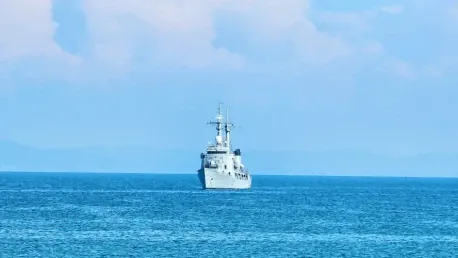In a significant stride toward bolstering its maritime and defense capabilities, Japan recently celebrated the launch of its first Landing Craft Utility (LCU), the Nihonbare. The commissioning ceremony took place on October 29, 2024, at the Naikai Zosen Corporation’s Setoda Shipyard in Hiroshima Prefecture, a landmark event attended by Deputy Minister of Defense ONIKI Makoto. Amidst growing regional tensions and evolving defense needs, this launch marks a step forward in Japan’s proactive approach to ensuring rapid and reliable sea transport, specifically in the strategically vital southwestern Nansei island chain near Taiwan and the Senkaku Islands.
Details of the Launch and Vessel
Launch Event Highlights
The ceremony, highlighting a milestone in Japan’s maritime defense strategy, witnessed key government and military officials coming together to commend the efforts in fortifying the nation’s defense infrastructure. The Nihonbare, costing around $27 million, reflects the Japan Ground Self-Defense Force’s (JGSDF) commitment to enhancing its operational readiness. Deputy Minister of Defense ONIKI Makoto underscored the importance of this vessel in ensuring that Japan can quickly and effectively respond to potential threats in the region. The attendees were given a first-hand look at the vessel’s impressive features and capabilities, emphasizing its role in Japan’s broader defense strategy.
A notable aspect of the Nihonbare is its capability to dock at relatively shallow ports and sandy beaches, a feature that greatly expands the range of operations it can support. At 80 meters long and displacing 2,400 tons, the vessel can transport 12 vehicles or a dozen 20-foot containers, making it a versatile addition to Japan’s fleet. The craftsmanship and precision engineering that went into building the Nihonbare signify Japan’s technological advancements and attention to detail in modern defense equipment.
Tactical Capabilities and Design
The Nihonbare’s design is particularly noteworthy for its ability to operate in varied and challenging environments. Its shallow draft allows it to access ports and coastal areas that are otherwise inaccessible to larger ships. The vessel can effectively bridge the gap between larger naval ships and smaller, more maneuverable craft, providing invaluable logistical support in complex maritime operations. The Nihonbare is manned by a crew of about 30, making it operationally efficient without requiring extensive personnel resources.
This LCU is part of a larger initiative by the Japan Ministry of Defense (JMOD), aiming to deploy a series of versatile vessels by fiscal 2027. The plan includes three additional small LCUs, two medium Logistics Support Vessels (LSVs), and four high-speed Maneuver Support Vessels (MSVs). These vessels will significantly enhance Japan’s ability to transport troops, supplies, and equipment across its extensive island territories. The emphasis on rapid deployment and operational flexibility underlines Japan’s strategic focus on maintaining a robust defense posture in the face of emerging regional threats.
Strategic Implications and Future Operations
Enhanced Defense Posture
The launch of the Nihonbare and the forthcoming vessels under the JMOD plan are strategically aligned with Japan’s ongoing efforts to strengthen its defense capabilities. This move is particularly pertinent given the increasing tensions in the East China Sea, especially around the Nansei island chain. By enhancing its maritime transport capabilities, Japan aims to ensure that it can swiftly and effectively reinforce its positions in these critical areas. The establishment of the SDF Maritime Transport Group marks a significant step toward more integrated and efficient military operations, combining the strengths of the Japan Maritime Self-Defense Force (JMSDF), Japan Air Self-Defense Force (JASDF), and the JGSDF.
Operating out of the Kure Naval Base in Hiroshima, the new joint-service unit symbolizes a shift toward a more cohesive defense strategy. The integration of different branches of the self-defense forces allows for better coordination and more streamlined operations, enhancing Japan’s overall defense readiness. The Nihonbare’s ability to transport high-mobility vehicles directly onto shorelines adds a critical capability that is expected to enhance Japan’s rapid response options in the event of a crisis.
Regional Defense Dynamics
In a significant advancement for its maritime and defense capabilities, Japan recently marked a milestone with the launch of its first Landing Craft Utility (LCU), named Nihonbare. The commissioning ceremony was held on October 29, 2024, at the Naikai Zosen Corporation’s Setoda Shipyard in Hiroshima Prefecture. This landmark event featured the attendance of Deputy Minister of Defense ONIKI Makoto. Given the increasing regional tensions and evolving defense requirements, this launch represents a progressive move in Japan’s strategy to ensure rapid and dependable sea transport. This strategic initiative is especially vital for the southwestern Nansei island chain near Taiwan and the Senkaku Islands, regions that hold significant strategic importance. The Nihonbare is poised to enhance Japan’s ability to respond swiftly to any emergencies or defense needs, reinforcing the nation’s preparedness in these critical areas. This launch underscores Japan’s commitment to strengthening its defense posture amidst a dynamic regional security environment.









